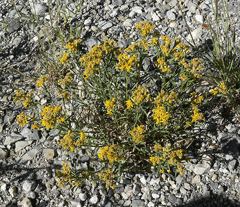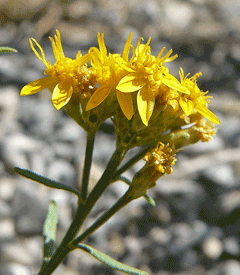 |
|
http://commons.wikimedia.org/wiki/User:Stan_Shebs |
 |
| http://commons.wikimedia.org/wiki/User:Stan_Shebs |
Translate this page:
Summary
Physical Characteristics

 Gutierrezia sarothrae is a deciduous Shrub growing to 1 m (3ft 3in).
Gutierrezia sarothrae is a deciduous Shrub growing to 1 m (3ft 3in).
See above for USDA hardiness. It is hardy to UK zone 8. It is in flower from August to October. The species is hermaphrodite (has both male and female organs) and is pollinated by Insects.
Suitable for: light (sandy), medium (loamy) and heavy (clay) soils and prefers well-drained soil. Suitable pH: mildly acid, neutral and basic (mildly alkaline) soils and can grow in very alkaline soils.
It cannot grow in the shade. It prefers dry or moist soil.
UK Hardiness Map
US Hardiness Map
Synonyms
G. divaricata. G. juncea.
Plant Habitats
Cultivated Beds;
Edible Uses
References More on Edible Uses
Medicinal Uses
Plants For A Future can not take any responsibility for any adverse effects from the use of plants. Always seek advice from a professional before using a plant medicinally.
Antirheumatic Astringent Cancer Cathartic Diuretic Laxative Pectoral Sedative
Skin Stings Stomachic
Broomweed was widely employed medicinally by several native North American Indian tribes who used it to treat a variety of complaints[257]. It is little, if at all, used in modern herbalism. A decoction of the roots has been used in the treatment of painful urination, diarrhoea and stomach aches[257]. The roots have been placed in boiling water and the steam inhaled in the treatment of respiratory complaints[257]. The flowers are laxative[257]. A decoction of the fresh flowers has been used in the treatment of diarrhoea[257]. The leaves are cathartic, febrifuge and sedative[257]. An infusion has been used in the treatment of coughs and colds[257]. It has also been used as a bath to treat fevers and sores, including those caused by venereal diseases[257]. A poultice of the moistened leaves has been used to treat bruises, wounds, sprains, nose bleeds and insect stings[257]. A protein in the plant is reported to have anti-cancer activity[274]. A strong, black infusion of the plant has been used as a rub on rheumatic joints[257].
References More on Medicinal Uses
The Bookshop: Edible Plant Books
Our Latest books on Perennial Plants For Food Forests and Permaculture Gardens in paperback or digital formats.

Edible Tropical Plants
Food Forest Plants for Hotter Conditions: 250+ Plants For Tropical Food Forests & Permaculture Gardens.
More

Edible Temperate Plants
Plants for Your Food Forest: 500 Plants for Temperate Food Forests & Permaculture Gardens.
More

More Books
PFAF have eight books available in paperback and digital formats. Browse the shop for more information.
Shop Now
Other Uses
Broom Dye Insecticide Kindling Soap
The twigs are tied to sticks and used as brooms[61, 257, 274]. The dried twigs were used as a kindling for starting fires[274]. A yellow dye can be made from the plant tops[257]. An infusion of the leaves has been used as a pleasant and refreshing bath[257]. The chewed leaf juice has an intoxication effect on bees and can kill them[257].
Special Uses
Scented Plants
References More on Other Uses
Cultivation details
Requires a position in full sun in a deep open well-drained soil[200]. Often found in calcareous soils in the wild[274]. This species is not hardy in the colder areas of the country, it tolerates temperatures down to between -5 and -10°c[200]. Plants are sub-shrubs and may die back to the base in winter[200]. Plants have deep taproots and resent root disturbance[200]. They should be planted into their permanent positions as soon as possible. Because it is unpalatable to livestock, this plant is often an indicator of overgrazed land[274]. Plants are strongly aromatic[200].
References Carbon Farming Information and Carbon Sequestration Information
Temperature Converter
Type a value in the Celsius field to convert the value to Fahrenheit:
Fahrenheit:
The PFAF Bookshop
Plants For A Future have a number of books available in paperback and digital form. Book titles include Edible Plants, Edible Perennials, Edible Trees,Edible Shrubs, Woodland Gardening, and Temperate Food Forest Plants. Our new book is Food Forest Plants For Hotter Conditions (Tropical and Sub-Tropical).
Shop Now
Plant Propagation
Seed - sow spring in a greenhouse and only just cover the seed. Prick the plants out into individual pots as soon as they are large enough to handle, using deep pots to accommodate the tap root. Grow on for the first winter in a greenhouse and plant out into their permanent positions in late spring or early summer[200]. Cuttings of half-ripe wood, July/August in a frame.
Other Names
If available other names are mentioned here
Native Range
NORTHERN AMERICA: Canada (Saskatchewan, Alberta, Manitoba), United States (Kansas, Minnesota, Nebraska, North Dakota, Oklahoma, South Dakota, Colorado, Idaho, Montana, Oregon, Washington, Wyoming, New Mexico, Texas, Arizona, California, Nevada, Utah), Mexico (Baja California (Norte), Baja California Sur, Chihuahua, Coahuila de Zaragoza, Durango, Nuevo León, San Luis Potosí, Sonora, Zacatecas)
Weed Potential
Right plant wrong place. We are currently updating this section.
Please note that a plant may be invasive in one area but may not in your area so it's worth checking.
Conservation Status
IUCN Red List of Threatened Plants Status :

Growth: S = slow M = medium F = fast. Soil: L = light (sandy) M = medium H = heavy (clay). pH: A = acid N = neutral B = basic (alkaline). Shade: F = full shade S = semi-shade N = no shade. Moisture: D = dry M = Moist We = wet Wa = water.
Now available:
Food Forest Plants for Mediterranean Conditions
350+ Perennial Plants For Mediterranean and Drier Food Forests and Permaculture Gardens.
[Paperback and eBook]
This is the third in Plants For A Future's series of plant guides for food forests tailored to
specific climate zones. Following volumes on temperate and tropical ecosystems, this book focuses
on species suited to Mediterranean conditions—regions with hot, dry summers and cool, wet winters,
often facing the added challenge of climate change.
Read More
Expert comment
Author
(Pursh.)Britton.&Rusby.
Botanical References
200
Links / References
For a list of references used on this page please go here
Readers comment
| Add a comment |
|
If you have important information about this plant that may help other users please add a comment or link below. Only comments or links that are felt to be directly relevant to a plant will be included. If you think a comment/link or information contained on this page is inaccurate or misleading we would welcome your feedback at [email protected]. If you have questions about a plant please use the Forum on this website as we do not have the resources to answer questions ourselves.
* Please note: the comments by website users are not necessarily those held by PFAF and may give misleading or inaccurate information.
To leave a comment please Register or login here All comments need to be approved so will not appear immediately.
|
Subject : Gutierrezia sarothrae
|
|
|
|